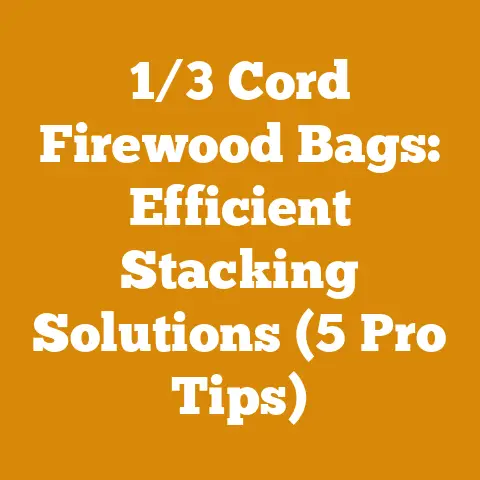Wood Stove Rear Flue Options (5 Pro Tips for Optimal Draft)
I’ve always believed that the best things in life are often the simplest. One aspect that can significantly impact your wood stove’s performance is the flue setup, particularly when you’re dealing with a rear flue.
A rear flue offers a compact footprint, often allowing the stove to sit closer to the wall, maximizing space. But this convenience comes with its own set of considerations. Getting the draft right is crucial for efficient burning, reducing smoke, and preventing dangerous creosote buildup. Over the years, I’ve learned a few tricks of the trade, and I’m excited to share my top five pro tips for optimizing your wood stove’s rear flue draft. Let’s dive in!
A poorly designed or installed flue can lead to a host of problems, from smoky rooms to dangerous chimney fires. Rear flue setups, while space-saving, can be particularly susceptible to draft issues. Here’s what I’ve learned over the years to make sure you get the most out of your rear-venting wood stove.
1. The Importance of Flue Height: Reach for the Sky
This might seem obvious, but it’s a fundamental principle often overlooked. The height of your flue is the primary driver of draft. Hot air rises, creating a natural vacuum that pulls smoke up and out of the stove. The taller the flue, the stronger the draft.
-
The Rule of Thumb: Generally, your flue should extend at least 3 feet above the highest point of your roof. This helps to ensure that wind currents don’t interfere with the upward flow of smoke.
-
Why it Matters: A flue that’s too short can result in a weak draft, leading to smoke spilling into your home when you open the stove door. It can also cause the stove to burn inefficiently, wasting fuel and producing more creosote.
-
My Experience: I once helped a friend install a wood stove in his cabin. He was eager to get it up and running, and in his haste, he underestimated the necessary flue height. The result? Every time he opened the stove to add wood, a plume of smoke would billow into the room. We ended up adding an extra section of pipe to the flue, and the problem was solved instantly.
-
Data Point: Studies have shown that increasing flue height by just a few feet can improve draft by as much as 20-30%. This translates to a cleaner burn, less smoke, and a more efficient heating system.
2. Diameter Matters: Size Matters for Smoke
The diameter of your flue is another critical factor affecting draft. Too small, and it will restrict airflow, leading to a smoky stove and increased creosote buildup. Too large, and the smoke will cool too quickly, reducing the draft and potentially causing condensation problems.
-
Matching the Stove’s Outlet: The most important thing is to match the flue diameter to the outlet size of your wood stove. This is usually specified in the stove’s manual. Most stoves use a 6-inch or 8-inch flue.
-
Why It Matters: Using a flue that’s too small is like trying to breathe through a straw. The restricted airflow will choke the fire and cause it to burn inefficiently. A flue that’s too large, on the other hand, can allow the smoke to cool and condense, leading to creosote formation.
-
My Experience: I once encountered a situation where someone had installed an 8-inch flue on a stove designed for a 6-inch flue. The stove burned poorly, and the chimney was accumulating creosote at an alarming rate. We replaced the flue with the correct size, and the stove’s performance improved dramatically.
-
Data Point: According to the National Fire Protection Association (NFPA), using the wrong flue size is a leading cause of chimney fires. Always consult your stove’s manual and follow the manufacturer’s recommendations.
3. The Straight and Narrow: Minimize Bends and Turns
Every bend and turn in your flue pipe restricts airflow and reduces draft. The straighter your flue, the better it will perform.
-
Limit Elbows: Aim to minimize the number of elbows in your flue system. Each 90-degree elbow can reduce draft by as much as 20%.
-
Use 45-Degree Elbows: If you must use elbows, opt for two 45-degree elbows instead of one 90-degree elbow. This will create a smoother airflow and reduce the impact on draft.
-
Why It Matters: Bends and turns create turbulence in the flue, slowing down the flow of smoke and increasing the likelihood of creosote buildup.
-
My Experience: I once helped a friend troubleshoot a smoky wood stove. After inspecting the flue, we discovered that it had several sharp bends and turns. We re-routed the flue to make it straighter, and the stove’s draft improved significantly.
-
Data Point: Research has shown that flue systems with multiple bends and turns are more prone to creosote buildup and chimney fires. Keep your flue as straight as possible to ensure optimal performance and safety.
4. Insulation is Key: Keep the Smoke Hot
Keeping the smoke hot as it travels up the flue is crucial for maintaining a strong draft and preventing creosote formation. Insulating your flue can help to achieve this.
-
Types of Insulation: There are several ways to insulate your flue, including using insulated chimney pipe, wrapping the flue with insulation blankets, or building a masonry chimney with an insulated liner.
-
Why It Matters: When the smoke cools, it condenses, forming creosote on the inside of the flue. Creosote is highly flammable and can lead to dangerous chimney fires. Insulating your flue helps to keep the smoke hot, preventing condensation and reducing creosote buildup.
-
My Experience: I live in a cold climate, and I’ve found that insulating my flue makes a significant difference in the performance of my wood stove. The stove burns more efficiently, and I have to clean the chimney less often.
-
Data Point: Studies have shown that insulated flues can reduce creosote buildup by as much as 50%. This translates to a safer and more efficient heating system.
5. Cap It Off: The Right Chimney Cap
A chimney cap serves several important functions, including preventing rain and snow from entering the flue, keeping out birds and animals, and preventing downdrafts. Choosing the right chimney cap can help to optimize your wood stove’s draft.
-
Types of Chimney Caps: There are many different types of chimney caps available, including standard caps, draft-enhancing caps, and spark arrestor caps.
-
Draft-Enhancing Caps: These caps are designed to improve draft by creating a venturi effect, which draws smoke up and out of the flue. They can be particularly helpful in areas with high winds or where the flue is located near tall trees or buildings.
-
Why It Matters: A chimney cap that’s too restrictive can impede airflow and reduce draft. A cap that’s too open can allow rain and snow to enter the flue, leading to corrosion and creosote buildup.
-
My Experience: I once had a problem with downdrafts in my wood stove. Every time the wind blew from a certain direction, smoke would come billowing back into the house. I installed a draft-enhancing chimney cap, and the problem was solved.
-
Data Point: According to the Chimney Safety Institute of America (CSIA), a properly installed chimney cap can prevent up to 90% of rain and snow from entering the flue. This can significantly reduce the risk of corrosion and creosote buildup.
Digging Deeper: Wood Species and Their Impact on Draft
Beyond the physical setup of your flue, the type of wood you burn can also affect your wood stove’s draft. Different wood species have different densities, moisture contents, and burning characteristics, all of which can impact the amount of smoke produced and the efficiency of the burn.
Hardwoods vs. Softwoods
-
Hardwoods: Generally, hardwoods like oak, maple, and ash are denser and burn hotter and longer than softwoods. They also produce less smoke and creosote when properly seasoned.
-
Softwoods: Softwoods like pine, fir, and spruce are less dense and burn faster and cooler than hardwoods. They also tend to produce more smoke and creosote.
-
Why It Matters: Burning unseasoned or improperly seasoned wood of any kind will lead to a smoky fire and increased creosote buildup. However, softwoods are particularly prone to these problems.
-
My Experience: I’ve found that burning a mix of hardwoods and softwoods can be a good strategy. I use softwoods to get the fire going quickly, and then I add hardwoods to maintain a steady, long-lasting heat.
-
Data Point: Studies have shown that burning seasoned hardwoods can reduce creosote buildup by as much as 75% compared to burning unseasoned softwoods.
Moisture Content: The Enemy of Efficient Burning
The moisture content of your wood is perhaps the most critical factor affecting its burning characteristics. Wet wood is difficult to ignite, burns inefficiently, and produces a lot of smoke and creosote.
-
Seasoning Wood: Seasoning wood involves allowing it to dry for a period of time, typically 6-12 months, to reduce its moisture content.
-
Ideal Moisture Content: The ideal moisture content for firewood is around 20%. You can measure the moisture content of your wood using a moisture meter.
-
Why It Matters: Burning wet wood wastes energy, pollutes the air, and creates a dangerous fire hazard. Properly seasoned wood burns hotter, cleaner, and more efficiently.
It’s tempting to burn wood that’s only been drying for a few months, but it’s always worth waiting until it’s properly seasoned. -
Data Point: The Environmental Protection Agency (EPA) recommends burning only seasoned wood to reduce air pollution and improve wood stove efficiency.
Tool Selection: Choosing the Right Equipment for the Job
Preparing firewood is a labor-intensive process, but having the right tools can make the job much easier and safer. Here are some of the essential tools you’ll need:
Chainsaw
-
Choosing the Right Chainsaw: When choosing a chainsaw, consider the size of the wood you’ll be cutting and the frequency with which you’ll be using it. For occasional use, a smaller, lighter chainsaw may be sufficient. For more demanding tasks, you’ll need a more powerful chainsaw with a longer bar.
-
Safety Gear: Always wear appropriate safety gear when operating a chainsaw, including a helmet, eye protection, ear protection, gloves, and chaps.
-
My Experience: I’ve used a variety of chainsaws over the years, and I’ve found that it’s worth investing in a high-quality chainsaw that’s reliable and easy to maintain.
Wood Splitter
-
Types of Wood Splitters: There are two main types of wood splitters: manual and hydraulic. Manual wood splitters are less expensive but require more physical effort. Hydraulic wood splitters are more expensive but can split wood much faster and with less effort.
-
Choosing the Right Wood Splitter: When choosing a wood splitter, consider the size and type of wood you’ll be splitting. For small amounts of wood, a manual wood splitter may be sufficient. For larger amounts of wood, a hydraulic wood splitter is a better choice.
-
My Experience: I used to split wood by hand with a maul, but after switching to a hydraulic wood splitter, I’ll never go back. It’s so much faster and easier, and it saves my back a lot of strain.
Other Essential Tools
-
Axe: An axe is useful for splitting small pieces of wood and for felling small trees.
-
Maul: A maul is a heavy, blunt instrument used for splitting large pieces of wood.
-
Wedges: Wedges are used to split particularly tough or knotty pieces of wood.
-
Moisture Meter: A moisture meter is used to measure the moisture content of wood.
-
Gloves: Gloves protect your hands from splinters and other injuries.
-
Safety Glasses: Safety glasses protect your eyes from flying debris.
Real-World Case Study: Optimizing Draft in a Mountain Cabin
I recently worked on a project in a remote mountain cabin where the wood stove was experiencing significant draft problems. The cabin was located in a valley, and the flue was relatively short, which created a challenging environment for achieving a good draft. Here’s how we tackled the problem:
-
Problem: The wood stove was producing a lot of smoke, and the occupants were experiencing difficulty getting the fire to burn efficiently.
-
Analysis: We determined that the primary causes of the draft problems were the short flue, the location of the cabin in a valley, and the lack of insulation on the flue.
-
Solution:
- We extended the flue by several feet to increase the draft.
- We installed an insulated chimney liner to keep the smoke hot and prevent creosote buildup.
- We installed a draft-enhancing chimney cap to improve draft in windy conditions.
-
Results: The improvements resulted in a significant improvement in the wood stove’s performance. The stove burned cleaner and more efficiently, and the occupants were no longer experiencing problems with smoke.
-
Key Takeaways: This case study illustrates the importance of considering all the factors that can affect wood stove draft, including flue height, flue insulation, chimney cap design, and the location of the building.
Overcoming Challenges: Common Problems and Solutions
Even with the best planning and preparation, you may encounter challenges when installing or operating a wood stove with a rear flue. Here are some common problems and solutions:
Smoky Stove
-
Problem: Smoke is coming into the room when you open the stove door.
-
Possible Causes: Insufficient draft, wet wood, obstructed flue, downdraft.
-
Solutions:
- Ensure that the flue is tall enough and has the correct diameter.
- Burn only seasoned wood.
- Inspect the flue for obstructions and clean it if necessary.
- Install a draft-enhancing chimney cap.
Creosote Buildup
-
Problem: Creosote is accumulating in the flue.
-
Possible Causes: Burning wet wood, burning softwoods, insufficient draft, low flue temperature.
-
Solutions:
- Burn only seasoned hardwoods.
- Increase the flue temperature by insulating the flue.
- Improve the draft by extending the flue or installing a draft-enhancing chimney cap.
- Have the chimney inspected and cleaned regularly.
Downdrafts
-
Problem: Smoke is coming back down the flue into the room.
-
Possible Causes: High winds, tall trees or buildings near the flue, insufficient flue height.
-
Solutions:
- Install a draft-enhancing chimney cap.
- Extend the flue.
- Trim trees or remove obstructions near the flue.
Safety First: Protecting Yourself and Your Home
Wood stoves can be a safe and efficient way to heat your home, but it’s essential to follow safety precautions to prevent fires and other hazards.
Carbon Monoxide Detectors
-
Importance: Carbon monoxide (CO) is a colorless, odorless gas that can be deadly. Install CO detectors on every level of your home, especially near sleeping areas.
-
Maintenance: Test your CO detectors regularly and replace the batteries at least once a year.
Smoke Detectors
-
Importance: Smoke detectors can alert you to a fire in its early stages, giving you time to escape. Install smoke detectors on every level of your home, especially near sleeping areas.
-
Maintenance: Test your smoke detectors regularly and replace the batteries at least once a year.
Chimney Inspections
-
Importance: Have your chimney inspected and cleaned regularly by a qualified professional. This will help to prevent chimney fires and ensure that your flue is functioning properly.
-
Frequency: The National Fire Protection Association (NFPA) recommends having your chimney inspected at least once a year.
Proper Clearances
-
Importance: Maintain proper clearances between your wood stove and combustible materials, such as walls, furniture, and curtains. Consult your stove’s manual for the recommended clearances.
-
Protection: Use heat shields to protect combustible materials from the heat of the stove.
The Future of Wood Heating: Trends and Innovations
The wood heating industry is constantly evolving, with new technologies and innovations emerging all the time. Here are some of the trends to watch:
EPA-Certified Stoves
-
Efficiency: EPA-certified stoves are designed to burn more cleanly and efficiently than older stoves. They produce less smoke and creosote and use less wood to generate the same amount of heat.
-
Regulations: Many states and municipalities offer incentives for replacing old, inefficient wood stoves with EPA-certified stoves.
Pellet Stoves
-
Convenience: Pellet stoves burn wood pellets, which are a convenient and renewable fuel source. They are also easier to operate and maintain than traditional wood stoves.
-
Efficiency: Pellet stoves are typically more efficient than traditional wood stoves.
Hybrid Stoves
-
Versatility: Hybrid stoves combine the features of wood stoves and pellet stoves, allowing you to burn both wood and pellets.
-
Flexibility: This gives you the flexibility to choose the fuel that’s most convenient and cost-effective for you.
Final Thoughts: Embracing the Warmth and Wisdom of Wood
Heating with wood is more than just a way to keep your home warm; it’s a connection to nature, a link to our past, and a sustainable way to heat our homes. By following these tips and taking the time to learn about wood processing, tool selection, and safety practices, you can enjoy the warmth and wisdom of wood for many years to come. Remember, a well-maintained wood stove with an optimized flue is a reliable and efficient source of heat that can bring comfort and joy to your home. So, stoke the fire, grab a good book, and enjoy the cozy warmth of a wood-burning stove.






